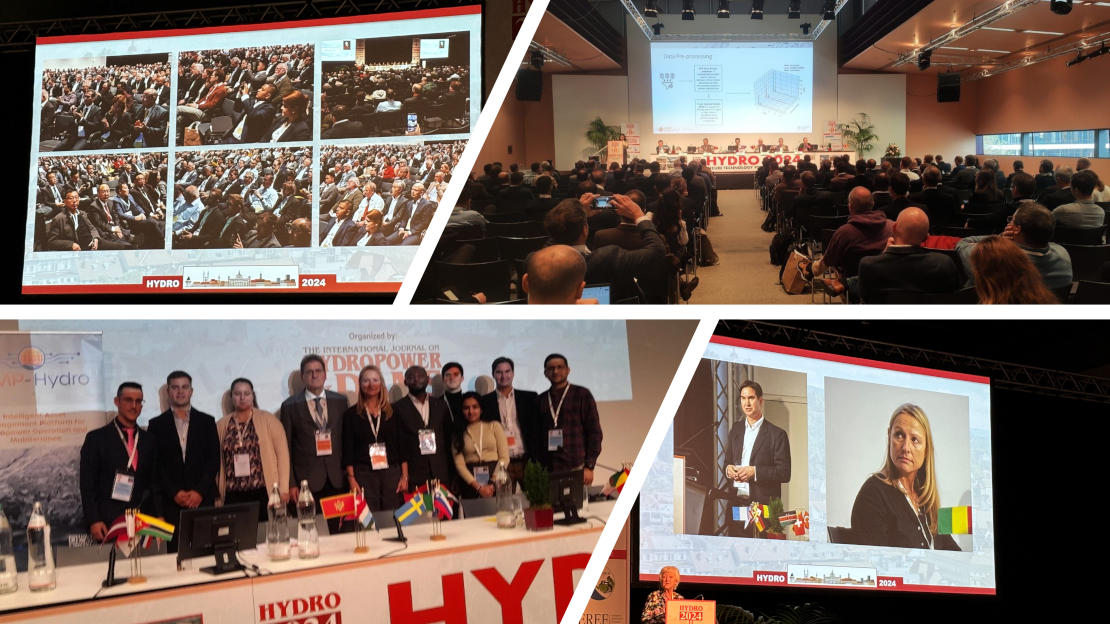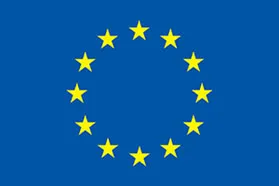
From 18 to 20 November the Austrian city of Graz has turned into the unofficial Capital of Hydropower as the renowned conference HYDRO 2024 was held there. The iAMP-Hydro project was honoured to chair a full session in Graz: Session 17: Digital solutions for operation and maintenance of existing hydropower. Almost 100 interested conference delegates participated in the session and were informed about the three sister projects that work in parallel on the issue (D-HYDROFLEX, Di-Hydro, and iAMP-Hydro). The presentations were about the three projects in general, predictive maintenance, application of computational fluid dynamics in digitalisation, the development of a flow and available power prediction and forecasting model, digital twins and decision support systems for enhanced hydro plant O&M, and about hybridization modelling (power-to-hydrogen). WIP (Ingo Ball) has organised and co-chaired the session together with the Polish Small Hydropower Association (Ewa Malicka).
Background for session 17 was that the current hydro fleet in the EU is aging, and it is estimated that 50 per cent of it will require upgrade actions by 2030. In particular, modernisation related to digitalisation is required in the short to medium term, to provide enhanced services, increase grid flexibility, environmental and socio-economic sustainability and to foster the green and digital transitions in Europe.
Three EU-funded projects which are working on this topic, were described by the deputy project coordinator of iAMP-Hydo, including their objectives, approaches, and results to be achieved.
[ See presentation]
An effect which is expected to be seen a lot more when hydropower plants need to be operated more often under off-design conditions to address supply gaps caused by intermittent energy sources like solar and wind will be that turbine wear and damage accelerate. Bhaskar Paudel from Trinity College Dublin showed that implementing advanced digital solutions for condition monitoring (CM) is a key step in shifting operation and maintenance (O&M) practices from preventive to predictive approaches. He presented a methodological approach to developing predictive maintenance (PdM) models for hydro turbines facing these challenges. His presentation highlighted the use of digital solutions, such as sensors and instrumentation, to acquire data for building numerical and machine learning-based predictive models.
[See presentation]
The interesting aspect of applying Computational Fluid Dynamics (CFD) with inverse design and advanced optimization techniques to modernize legacy hydropower systems was presented by Israel Ohiemi from Trinity College Dublin. He explained how CFD is enabling efficient, sustainable operations without requiring plant shutdowns or direct component access.
[See presentation]
Bogdan Popa, professor at POLITEHNICA Bucharest, presented the joint work (together with colleagues from Spanish CARTIF) on the development of novel flow and power prediction models of the five validation sites of iAMP-Hydro. For one of the plants, for HPP Bermejales (a toe dam hydropower plant, operated by the Spanish company CUERVA, 2.1 MW of installed capacity and 100 hm3 live storage reservoir, primarily used for irrigation purposes) the AI-based model developed by CARTIF was described. The AI-based modelling approach consisted of developing a medium term forecasting model for predicting the water storage in the reservoir of Bermejales, the details were presented.
The second part of the presentation covered the two Greek validation sites of iAMP-Hydro, HPP Asomata (a toe dam hydropower plant with 108 MW installed capacity and 10 Mm3 live storage reservoir, being the fourth in a five reservoirs cascade and, same time, lower reservoirs for Sfikia pumped storage plant) and HPP Makrochori (10.8 MW installed capacity, located on the irrigation channel for which Agia Varvara is a 3 Mm3 live storage reservoir). Data used for forecasting were daily recorded values for inflows from 2011 to 2022 for Asomata Reservoir and from 2010 to 2022 for Agia Varvara Reservoir. The programs were applied only for data until 2021 and the forecast was performed for 2022, comparing the predicted values with the measured ones using programmes developed in MATLAB with ARIMA and Artificial Neural Network (ANN). The results were promising and will be further used for all iAMP-Hydro validation sites.
[See presentation]
Nicola Crippa from MAS Consulting Srl. presented one aspect of the Di-Hydro project: Digital Twins (DTs) and Decision Support Systems (DSSs). DTs aim to replicate physical assets in a virtual environment, enabling simulation processes to assess the health condition of the HPPs components and identify the optimal maintenance schedule. DSSs complement DTs supporting the HPP operators in complex decision-making processes, and providing them with data-driven insights valuable to make robust and effective decisions to maximise the economic benefit.
The presentation focused on the description of the minimum requirements needed to effectively realize and integrate DTs and DSSs to optimize the operations and maintenance of hydropower plants. One critical aspect when realizing DTs consists of identifying the optimal simulation depth of the HPPs components, balancing simulation details and cost-effective solutions. Besides, regarding the DSSs, it is important to focus on the input data management allowing the users to perform scenario-based optimisations to improve the robustness of the decisions. The integration of DT and DSS can lead to further value. The maintenance schedule output of the DT can be used as input for the optimisation model of the DSSs to compute the optimal production schedule. In turn, this latter can be simulated by the DT to assess its effects on the health of the HPP component. This process allows the HPP operators to make optimal decisions both in terms of HPP production and health status.
[See presentation]
The last presentation was given by Sergio Rodríguez (CARTIF, working in the D-HYDROFLEX project) who gave a presentation about “Hybridization Modelling (Power-to-Hydrogen)” highlighting the innovative strategies developed to optimize the integration of renewable energies and enhance the flexibility of the power grid. Two hybridisation scenarios were presented: a small-scale micro-hydroelectric plant and a larger, seasonal hydroelectric plant, both integrated with photovoltaic technologies and hydrogen storage systems. Using the TRNSYS simulation software, they analyzed the performance of these hybrid systems under real conditions in the energy market. The results showed that hybridized hydroelectric plants not only achieved higher revenues and energy production but also, by combining with hydrogen storage, significantly improved the flexibility and stability of the power system. The research underlines the potential of hybridization as a strategic solution for maximizing the use of renewable energies and advancing toward decarbonization goals
[See presentation]
As very brief summary of the session can be said that research projects like iAMP-Hydro, Di-Hydro and D-HYDROFLEX could contribute to the Net Zero goals, and at the same time mean a relief for the electricity grids which play a more and more important role in our world.
We like to thank the organisers of the HYDRO conference for giving us the opportunity to present our work and are looking forward to the next conference, HYDRO 2025, which will take place from 22-24 October 2025 at Helexpo, in Thessaloniki, Greece.
